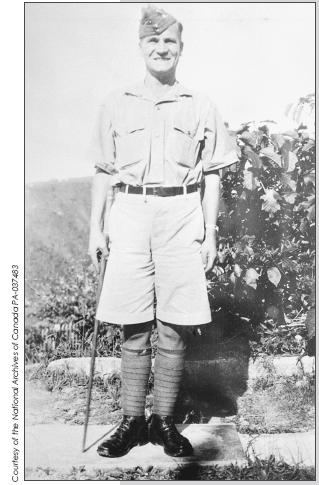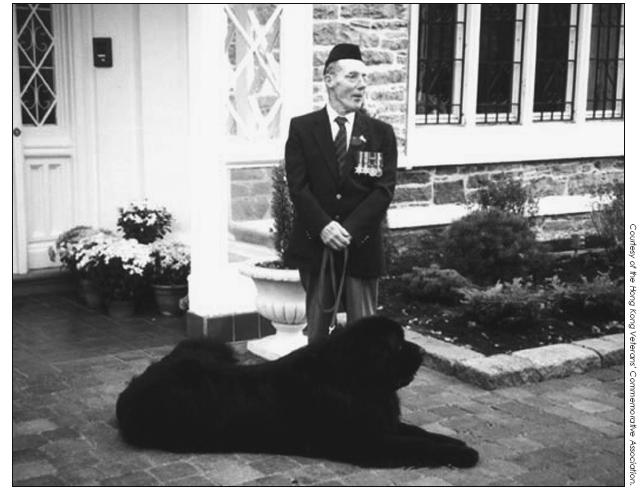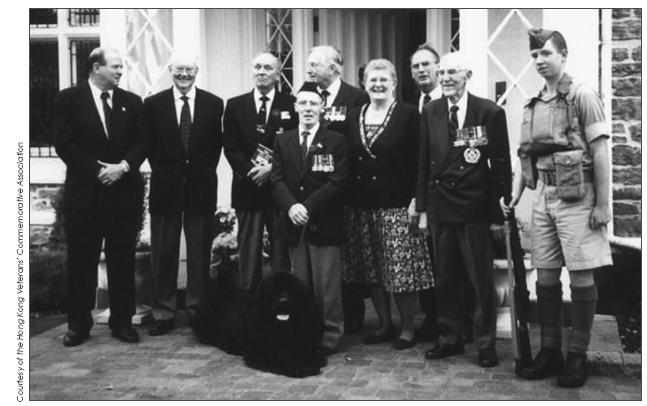Sergeant Gander (10 page)

Sergeant Major John Osborn
John Robert Osborn was born in England in 1899
and saw action in the First World War as a seaman
in the Royal Naval Volunteer Reserve. After the
war he immigrated to Canada, where he farmed
and worked for the Canadian Pacific Railway. He
married and had five children. In 1933, he joined
the Winnipeg Grenadiers and was called to active
duty six years later, in September 1939. Sergeant
Major John Osborn was the first Canadian to receive
the Victoria Cross in the Second World War, and his
was the only Victoria Cross awarded for the Battle of
Hong Kong. It is on display at the Canadian War
Museum in Ottawa. He was forty-two years old when
he died and has no known grave, but his name can
be seen on the Hong Kong Memorial at the entrance
to the Botanic Gardens in Victoria, Hong Kong.

Company Sergeant Major Osborn, Winnipeg Grenadiers, Jamaica, 1940/41.
Sergeant Major John Osborn's Citation
At Hong Kong, on the morning of the
19th of December 1941, a company of the
Winnipeg Grenadiers to which Company
Sergeant-Major Osborn belonged, became
divided during an attack on Mount Butler,
a hill rising steeply above sea level. A part of
the company led by Company Sergeant-Major Osborn captured the
hill at the point of the bayonet and held it for three hours when, owing
to the superior numbers of the enemy and to fire from an unprotected
flank, the position became untenable. Company Sergeant-Major
Osborn and a small group covered the withdrawal, and when their
turn came to fall back, Osborn, single-handed, engaged the enemy
while the remainder successfully joined the company. Company
Sergeant-Major Osborn had to run the gauntlet of heavy rifle and
machine-gun fire. With no consideration for his own safety, he assisted
and directed stragglers to the new company position, exposing himself
to heavy enemy fire to cover their retirement. Wherever danger
threatened he was there to encourage his men.
During the afternoon the company was cut off from the battalion
and completely surrounded by the enemy, who were able to approach
to within grenade throwing distance of the slight depression which
the company was holding. Several enemy grenades were thrown,
which Sergeant-Major Osborn picked up and threw back. The
enemy threw a grenade, which landed in a position where it was
impossible to pick it up and return it in time. Shouting a warning
to his comrades this gallant Warrant Officer threw himself on the
grenade, which exploded, killing him instantly. His self-sacrifice
undoubtedly saved the lives of many others.
Company Sergeant-Major Osborn was an inspiring example
to all throughout the defence which he assisted so magnificently in
maintaining against an overwhelming enemy force for over eight
and a half hours, and in his death he displayed the highest quality of
heroism and self-sacrifice.
also assist in the support and welfare of Hong Kong veterans and their widows.”
2
In 2001, the administration and finances of the two groups were merged. The HKVA still participates in its own in commemorative programs with Veterans' Affairs Canada, and also plays an active role in the HKVCA by educating Canadians about the Battle of Hong Kong.
The men of the Royal Rifles of Canada always felt that Gander deserved recognition for his selfless act. In 1995, Jeremy Swanson, then commemorations officer at the Canadian War Museum, heard the story of Gander from some of the veterans. The veterans had come together for a special meeting of the HKVA where they all received their Hong Kong clasps, an award introduced by the Canadian government in July 1995 to recognize the contributions made by the Canadian soldiers at the Battle of Hong Kong. They were reminiscing about the story of Sergeant Major J.R. Osborn, the Canadian soldier who had been awarded the Victoria Cross for his heroism at the Battle of Hong Kong. Osborn had saved the lives of several men in his company by throwing himself on top of a Japanese grenade.
As they chatted about the Sergeant Major's heroism one of the veterans made the comment, “Just like that damned dog.” Swanson's interest was piqued and he quizzed the veterans for more information. From what Swanson could glean, Gander, the canine mascot of the Royal Rifles of Canada, had performed an act of heroism that was strikingly similar to that of Sergeant Major Osborn's. Fascinated by Gander's story, Swanson and a small group of volunteers, including Howard Stutt of McGill University, began researching the tale to verify its truthfulness and to separate fact from fiction. After researching Gander's story extensively, Swanson
Jeremy Swanson
Jeremy Swanson was the commemorations and operations officer to Programs and
Collections at the Canadian War Museum (CWM) from 1992â2002. An emigrant
from South Africa, Swanson has played a vital and active role in helping to research
and preserve Canadian military history. During his tenure with the CWM, Swanson
conducted research and historical overviews of numerous CWM exhibitions and
literary projects, including “Canada's Armed Forces 1945â50” and “Canada in
Korea,” as well as planning and leading a successful search for families of the twenty-
six Canadian airmen killed over Poland during the Second World War.
Swanson helped spearhead the campaign for Sergeant Gander's PDSA Dickin
Medal, committing hundreds of hours to research, and was responsible for organizing the
PDSA Dickin Medal ceremony that was held at the British High Commission in Ottawa
in October 2000. Currently, Swanson is working as a men's rights activist in Ottawa.
unearthed numerous military and eyewitness accounts of Gander's heroism. Swanson felt strongly that Gander was deserving of a posthumous award for bravery.
The People's Dispensary for Sick Animals (PDSA) is a veterinary charity in the United Kingdom that was founded in 1917 by Maria Dickin. Born in London in 1870, Dickin (Mia to her friends) was the daughter of a minister and the eldest of eight children. At twenty-eight years of age she married her wealthy cousin, Arnold Dickin, and gave up her job â she owned a successful voice production studio â to look after her new household and assume the role of society wife. Horrified by the plight of the animals in London's poverty-stricken East End, Dickin explained that “the suffering and misery of these poor uncared for creatures was a revelation to me. I had no idea it existed and it made me indescribably miserable.”
3
She decided to make the provision of veterinary care for the poor her social cause, and on November 17, 1917, she opened her first dispensary. A notice advertising the opening read simply: “Bring your sick animals. Do not let them
Victoria Cross
Introduced by Queen Victoria in 1856, to reward acts of valour during the Crimean
War (1853â56), the Victoria Cross (VC) is the highest award for valour “in the face
of the enemy” in the United Kingdom, some Commonwealth countries, and former
British Empire territories. It may be awarded to any enlisted personnel (any rank)
or civilians under military command. The VC is awarded for, “most conspicuous
bravery, or some daring or pre-eminent act of valour or self sacrifice, or extreme
devotion to duty in the presence of the enemy.” The medal is extremely rare, having
been awarded only 1,356 times to 1,353 recipients since its inception.
6
It is a bronze
cross with a Crown and Lion superimposed and the words, “For Valour.” Ninety-four
Canadians have been awarded the British Victoria Cross, none since 1945. Since
Newfoundland was not part of Canada prior to 1945, Victoria Cross recipients from
Newfoundland are identified separately. In 1993, it was decided that Canadians
would no longer be eligible for the British Victoria Cross â it was replaced by a
Canadian Victoria Cross and has yet to be awarded.

Fred Kelly with Rimshot.
suffer. All animals treated. All treatment free.”
4
The response was overwhelming, and soon Dickin began opening more dispensaries. By 1935, she had established five PDSA hospitals, seventy-one dispensaries, and eleven mobile dispensaries, eventually expanding her philanthropic endeavours to Greece, Egypt, South Africa, and Palestine. Although Dickin died in 1951, at the age of eighty-one, her legacy to the care of animals continues as the PDSA is still going strong today.

Gander's medal cerâemony. Jeremy Swanson (far left), Fred Kelly (holding leash), Rimshot (front), and Eileen Elms (nee Chafe, the little girl from the sled photoâgraph).
Maria Dickin established the PDSA Dickin Medal in 1943 to recognize “any animal displaying conspicuous gallantry or devotion to duty whilst serving with the British Commonwealth armed forces or civil emergency services.”
5
The bronze medallion bears the words, “For Gallantry” and “We Also Serve” and is considered the animals' Victoria Cross. Since its inception it has been awarded sixty-two times (as of 2008). With the documentation provided by Jeremy Swanson, the Hong Kong Veterans' Association forwarded an application to the PDSA requesting that Gander be considered for the PDSA Dickin Medal.
The PDSA was stunned to receive the medal request, as no such request had been submitted in over fifty years. After reviewing the extensive documentation accompanying the application for Gander's medal the PDSA quickly approved awarding the medal to Gander. Then PDSA Director General Marilyn Rydstrom stated, “We were surprised to receive the Association's request and comprehensive support documentation â the first in over fifty years to be submitted to the PDSA. Gander's story exemplifies the heroism displayed by many animals who served alongside British and Commonwealth forces during the Second World War. In some cases they performed outstanding acts, as did Gander, while others played equally significant roles by boosting morale among prisoners of war, carrying vital messages, and detecting humans and animals buried under bomb damaged buildings. We are delighted to add Gander's name to this illustrious list.”
7
On October 27, 2000, an award ceremony was held at the British High Commission in Ottawa. Members of the PDSA, the Hong Kong Veterans' Association, and the Royal Rifles of Canada, as well as many other invited guests, were on hand as Gander's old handler, Fred Kelly, accepted Gander's medal from PDSA Chairman Sir Roland Guy. Kelly, gently patting Rimshot, the Newfoundland dog that had been brought in to represent Gander, stated, “It's an honour just to be able to put my hand on this dog.”
8
Then, with his emotions taking over, Kelly declared, “I only wish that Gander had lived so that I could have taken him home. This is the happiest day of my life.”
9
